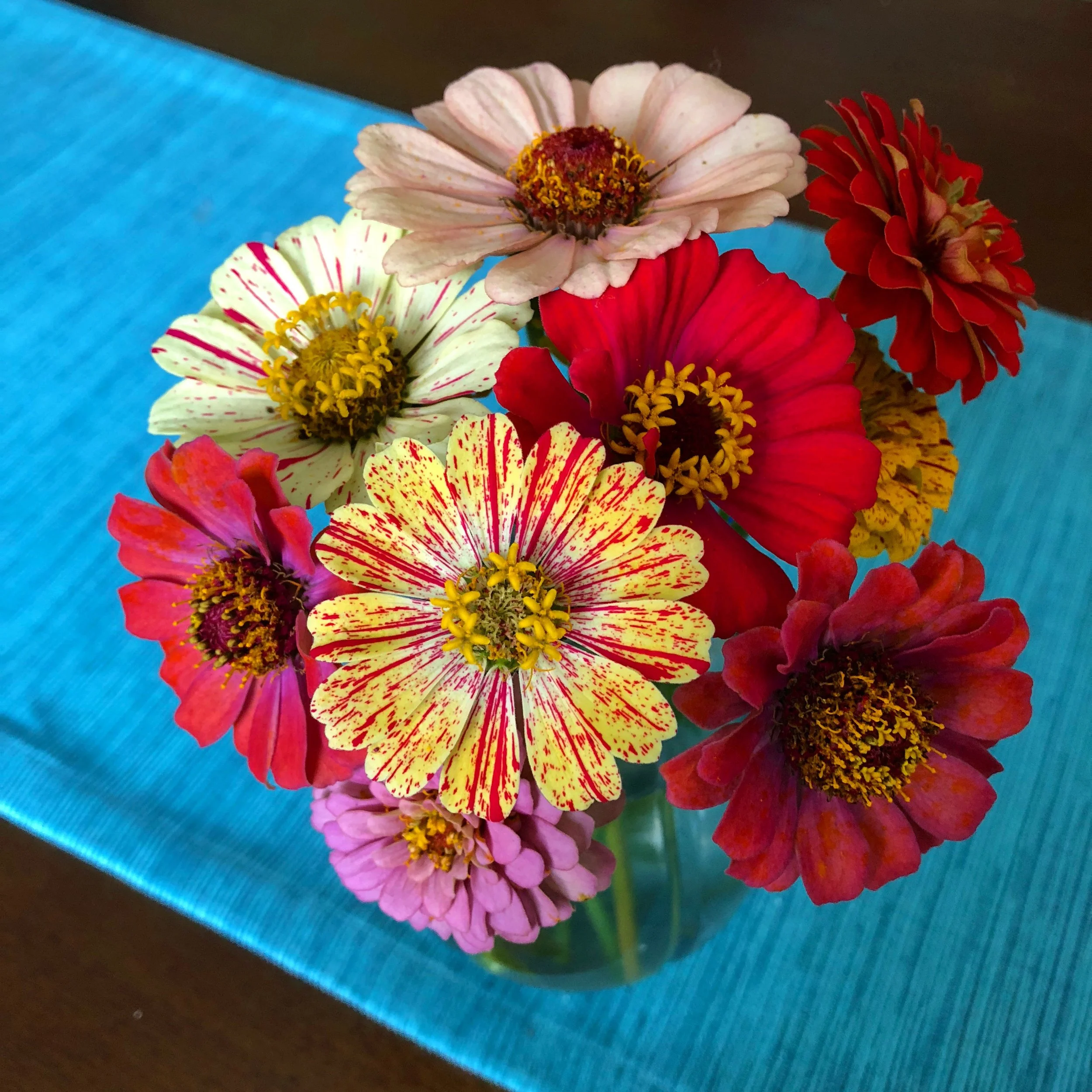The spring after we moved into our house, I hired a local landscape designer to help me figure out what I already had growing, what I should remove or relocate and what else I should plant. At one point, she suggested that I could plant some annuals in the beds in front of our house after the daffodils finished blooming in the spring, and I remember thinking that there was no way I was going to waste time planting something that would only last one season. It would be perennials or nothing!
Well, things have changed since then. My grandmother passed away in March of this year, and on May 8, what would have been her 98th birthday, I decided to buy some zinnias in her memory. They were one of her favorite flowers, she had told me in an email last year, because they made such good cut flowers, and she’d fill vases full of them for guests.
So I went to H.J. Benken Florist & Garden Center in Silverton, not far from my house, and bought six zinnia plants that had already started flowering: two red, two yellow and two pink. I had done some reading about them and gathered that I might have been better off if I had planted them from seed, but I just didn’t want to wait to enjoy the blooms.
The zinnias the day I bought them.
Below is how they looked shortly after I planted them in the flower bed on the west (and sunniest) side of my house, and before I put down new mulch. The two green clumps on the left are Black-Eyed Susans, and the other thing just to the left of the yellow zinnias is a daylily (whose blooms get eaten by deer every year so I’m about to yank it out).
The zinnias just after planting and before mulching.
I thought everything was looked pretty promising, but a week or two later, I bought a packet of “cut and come again” zinnia seeds just in case and planted them toward the front of the flower bed. This variety was supposed to grow to a height of two to three feet, much taller than what I’m guessing was a dwarf variety that I bought from Benken, and were designed to be cut to spur regrowth, as the name implies.
Zinnia seedlings emerging from freshly mulched beds.
Well, little did I know how GINORMOUS the Black-Eyed Susans would get — so much so that they blocked most of the sunlight to the zinnias except for the yellow ones. Additionally, almost immediately, something started eating the leaves — slugs or some sort of bug(s) (more about that, and my attempted remedies, in a future post) — and they just started looking really sad in general. Additionally, zinnias apparently hate getting their leaves wet, and not having the opportunity to dry out after rainfall probably helped do them in.
I was about ready to throw in the towel on my zinnia experiment, but happily, the zinnias I planted from seed saved the day. It took probably three months for them to bloom, but once they did, they were gorgeous. I wasn’t expecting such an incredible variety — the seed packet just showed the standard yellow, orange, pink and white varieties — but I ended up with some cool stripey versions that are my absolute fave. (I’m sure there’s a proper name for them; I just don’t know what it is.) Also, they got HUGE — I’m five feet tall and some of them are legit coming up to my chin.
The aforementioned freaking huge zinnia.
I also did some further research on the seed packet I bought and had the foresight to save. It’s from the Livingston Seed Co., which is headquartered in Columbus, just 90 minutes north of Cincinnati. The company claims to be “the number one supplier of top-quality, non-GMO vegetable and flower seeds for independent businesses” so I’m happy to keep giving them my business. (If you’re in Cincinnati, I bought my seeds at Woods Hardware downtown).
Now, I have enough zinnias to cut a bunch every week and put them on my kitchen table in some rainwater from my rain barrel (more about my rain barrel in a future post too). They last one to two weeks and make me happy every time I look at them. I think my grandmother would be proud.
The Late Bloomer Lowdown
I’ll plant zinnias again next year, but only from seed, and I’ll likely buy this exact seed packet again. Seriously, don’t waste your money buying zinnias that have already flowered. Do this instead:
Plant them from seed after the last frost has passed in your area in the sunniest area of your yard. The Old Farmer’s Almanac recommends sowing them about ¼-inch deep and 4 to 24 inches apart, depending on what your seed packet says. I was not nearly this exact but I’ve learned that circulation is important to prevent bacterial wilt, fungal spots and powdery mildew, so I’ll space them further apart next year.
Water them well at first to get them established, but only in the morning on sunny days so the leaves have the opportunity to dry out. Keep the soil moderately moist. I watered mine pretty irregularly and they were fine.
Deadhead spent flowers and don’t be afraid to cut them to prolong flowering, and enjoy.
Posted while listening to: Autumn Town Leaves by Iron & Wine
